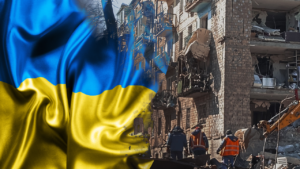We’re continuing to catch up with the ongoing dialogue about Development in a Box and need to point to this extremely insightful post by Shawn Beilfuss at Asia Logistics Wrap. In the post an an accompanying PowerPoint concept graphic, Shawn, who has both intellectual ambition and intellectual firepower, reconciles Development in a Box and other aspects of Enterprise Resilience Management with Tom Barnett’s Four Flows, and with the Five Supply Chain Architectures identified by Dr. Joseph Cavinato of Thunderbird, The Garvin School of International Management. Shawn suggests that Development in a Box might be the “glue” that ties the concepts together — and, more to the point, makes it possible to translate the concepts into pragmatic actions and results.
The exploration is fascinating, and illuminates several key points about Enterprise Resilience Management. Shawn writes:
It is safe to assume that the large majority of targeted entities, especially “Gap” entities, will not possess the conditions required to absorb the content modules of an entire “Development in a Box” delivered solution simultaneously given a specific scenario. In this case, customized modules can be delivered via the ERM framework ensuring timing and sequencing capability, degrees of granularity, scalability, connectivity and continuity between and across modules, in addition to ensuring an entire layer of system adaptability and sustainability in the face of advantageous and disadvantageous system perturbations of various criticality. (That was a mouth-full!) The ERM framework would consist of triggers that are “pulled” based on both scenario complexity and scenario hierarchy that signal the necessity for task, process, or strategy level change(s). In this type of matrix, any development solution can be broken down into individual modules, or any combination of individual modules that would then comprise the appropriate solution set.
Of course, depending on the conditions of the regional, state or local entity in question, the appropriate module configuration and granularity in regards to sequencing and timing will vary. Since all entities will be in some stage of development, it becomes necessary for the solution provider to modularize what has already taken place using the above matrix, assign measurements of progress, determine the ongoing sequence and timing, and then establish the ERM framework that will align those modules to an entity’s particular strategy and necessary rule sets that build in the adaptability and sustainability required for the environment in question.
Yes, exactly. As we’ve discussed recently here and here, modularity is an essential feature of Enterprise Resilience Management, and therefore of Development in a Box. Modularity applies at both technical and conceptual levels. The result is a practical, scalable solution. Shawn is correct — in the field, a Development in a Box implementation might consist of only a few modules, addressing only a few institutions or processes. The same is true of any organization that adopts an Enterprise Resilience Management Solution — the ERM framework makes it possible to automate a single process, with the option of adding others later. There are several benefits to this approach — speed, flexibility and cost-effectiveness. In the specific context of Development in a Box, modularity helps ensure that the resulting solution is responsive to local conditions — and driven by those conditions, rather than by ideologies or externally imposed systems. A modular framework addresses — and can be adjusted to accommodate — conditions as they are found and as they evolve.
Shawn also understands the potential of Enterprise Resilience Management to break down silos and address complex, interdependent challenges — as illustrated by his detailed example of a Development in a Box implementation to address the challenges immigration in Japan. This is obviously not a post-conflict or failed-state scenario — but as such, is serves to demonstrate the flexibility of the framework. In Shawn’s view, the Development in a Box framework enables systems (Cavinato’s five supply chain architectures) to respond to the impact of globalization (Barnett’s four flows):
…architectures created for economic flows alone are quite vulnerable to parallel failings in non-integrated architectures designed for political, security and people flows. This is where the ERM framework says “Oh, for that module you are working on, and with the given constraints, these are the best practices catalogued for a matching political flow informational architecture on immigration process management.” How cool would that be? Well, I believe that is what Barnett and DeAngelis are aiming for (although they can correct me on that one of course!). And because such a system can be accessed to reassess immigration at a future date based on modules of updated, global best practices, Japan in this case receives an adaptive, sustainable solution that drives the resiliency it desires.
Emphasis Shawn’s. Again — agreed. The example (worth reading in full, as is the whole post) demonstrates not only the flexibility of Development in a Box, but the potential for Enterprise Resilience Management (which is the basis for the Development in a Box framework) to connect disparate systems with each other, and to enable them to respond to stressors that affect, not just individual systems, but the system (whether organization, or nation-state, or transnational system) as a whole.
Shawn clearly understands both the impact of Enterprise Resilience Management and its potential to address a variety of challenges in a variety of settings. And by connecting Development in a Box — an application of ERM in certain critical situations — to the broader advantages of ERM, he helps move the discussion forward. Once again, it’s good to be in the company of smart, engaged colleagues who are addressing a common set of critical needs. This kind of open, flexible discussion draws on multiple viewpoints and resources — and in so doing, creates its own form of resilience.




